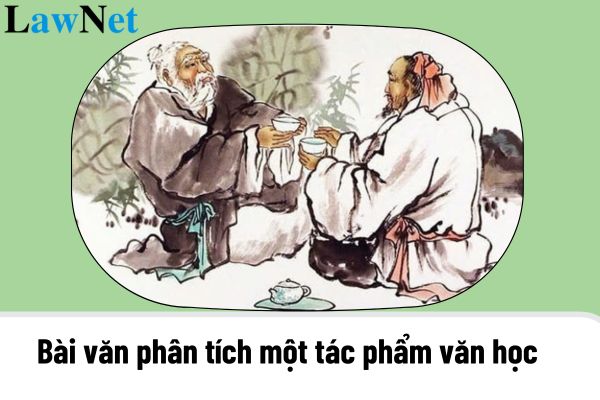Vietnam: What are the sample essays on the analysis of a seven-word eight-line or seven-word four-line poem?
What are the sample essays on the analysis of a seven-word eight-line or seven-word four-line poem?
Students and teachers may refer to the following sample essays on the analysis of a seven-word eight-line or seven-word four-line poem:
1. Analysis of the Poem "Cảnh khuya" by Ho Chi Minh (Seven-word Eight-line Poem)
| The poem "Cảnh khuya" by Ho Chi Minh is one of the prominent works in the collection "Prison Diary," written when the revolutionary fighter was imprisoned by the French colonialists. With the seven-word eight-line poetic form, the poem expresses the author's solitude and tranquility during the late night, while also revealing a love for nature, a vast soul, and the dignity of a resilient fighter. The poem begins with the line "Quảng trường vắng vẻ ánh trăng soi," creating a tranquil and desolate space. The phrase "moon shines" evokes the mysterious, both vague and clear beauty of the moonlight, highlighting the picture of the late night. This line not only reflects the tranquil space but also creates a profound image in the reader’s soul. Following this, in the line "Bóng cây trúc lay động mặt nước," the bamboo and water surface become symbols of serenity and peace in the late night scene. This imagery is not just of nature but also reflects the author's state of mind in moments of solitude and contemplation. Although imprisoned, Ho Chi Minh maintained calmness and steadfastness in the face of all challenges. The poem's highlight is the line "Cảnh khuya như vẽ người chưa ngủ." This is a delicate image, describing such stillness that it can be “drawn.” Surely, at this moment, the author is not just observing but also expressing thoughts and awakenings about life and the worldview around. The line also clearly reflects the sensitivity and perceptiveness of the artist, who even in difficult circumstances can deeply perceive nature and life. From these elements, the poem does not merely describe the scenery but also portrays the author's soul - a resilient soul that remains steadfast even in imprisonment, still appreciating the beauty of nature. Through "Cảnh khuya," Ho Chi Minh represents not only the tranquility and serenity of nature but also the freedom and peace in the soul, clearly reflecting the character and ideals of a revolutionary fighter. |
2. Analysis of the Poem "Tự tình II" by Ho Xuan Huong (Seven-word Eight-line Poem)
| The poem "Tự tình II" by Ho Xuan Huong is one of the distinctive works of the renowned female poet in classical Vietnamese literature. Written in the seven-word eight-line form, the poem reflects the sentiments of a woman in feudal society, facing loneliness, humiliation, and the yearning for freedom and love. At the beginning of the poem, Ho Xuan Huong writes: "Chồng xa, chồng nhớ, vợ thương, vợ chờ." This line opens up a space of separation, longing, and waiting in a lonely life. However, within this line, there is also irony, as the woman has to endure this separation in silence, without expressing or revealing her emotions. Next, "Tựa gối ôm chân, nghĩ đến tình chung," Ho Xuan Huong depicts the image of a woman in sorrowful circumstances, anxious due to unfulfilled love. The phrase "tựa gối ôm chân" suggests fatigue and tension within when enduring an unfulfilled life. But notably, in this line, the author not only conveys sorrow but also sends a message of the desire for love, the longing to be loved and shared. In the line "Mảnh trăng thề, mấy nỗi chờ mong," the image of the crescent moon evokes a sacred promise, yet also serves as a reminder of disappointments and unfulfilled expectations. The moon symbolizes eternity, yet it can only illuminate the darkness, much like the aspirations of women in old societies - always waiting, hoping without reciprocation. From these images, the poem "Tự tình II" by Ho Xuan Huong clearly depicts the sorrow, humiliation, and desire for freedom of women in feudal society. However, through Ho Xuan Huong's writing, the woman in the poem is not just an object of endurance but also a figure full of strength with the ability to self-recognize and affirm herself. Loneliness and the desire for love are pervasive themes in the poem, but at the same time, they are a powerful voice for women's right to life and love. The poem "Tự tình II" not only reflects a personal story but also speaks for all women in feudal society, those who were not able to live truly for themselves, having to conceal their desires and emotions. Through this work, Ho Xuan Huong skillfully conveys messages about love, suffering, and the yearning for freedom, while reflecting the feudal society and its dark sides in human life. |
*Note: The information is for reference purposes only./.

What are the sample essays on the analysis of a seven-word eight-line or seven-word four-line poem? (Image from the Internet)
What types of texts will 9th-grade students in Vietnam learn in the Literature curriculum?
Under Section 5 of the General education program in Literature issued together with Circular 32/2018/TT-BGDDT, 9th-grade students in Vietnam will learn the following 04 types of texts in the Literature curriculum:
- Narrative text: storytelling, simulating a story already read; storytelling by converting content from a comic.
- Expressive text: poetry with eight syllables; a paragraph expressing thoughts on an eight-syllable poem.
- Argumentative text: the role of arguments, reasoning, and evidence in presenting the content of an argumentative text; an argumentative essay presenting problems and solutions; an analysis essay on a literary work.
- Informational text: presenting ideas and information in text; expressive effectiveness of non-verbal means in informational text; explanatory text on a social phenomenon; a textual explanation of a scenic spot or historical site; advertising, leaflet.
What are the required outcomes regarding reading comprehension of the content of literary texts for 9th-grade students in Vietnam?
Under Section 5 of the General education program in Literature issued together with Circular 32/2018/TT-BGDDT, the required outcomes regarding reading comprehension of the content of literary texts for 9th-grade students in Vietnam are as follows:
- Identifying the comprehensive content of the text; initially analyzing representative details, themes, stories, characters in the integrity of the work.
- Identifying and analyzing the subject, ideology, and message that the text intends to convey to the reader through the artistic form of the text; analyzing some bases to determine the subject.
- Identifying and analyzing the feelings, emotions, and dominant inspiration of the writer expressed through the text.

